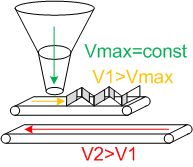Answer the question
In order to leave comments, you need to log in
Filling machine on Arduino
I want to assemble a small device for filling and packing small items (beads, beads)
Please tell me what sensors and / or components exist with the ability to separate small parts from a common pile one at a time with the possibility of electronic control?
Or what patterns for solving such problems should be googled?
Thank you.
Answer the question
In order to leave comments, you need to log in
Feeding from a conical container into a thin chute, and accurate sorting by a horizontal wheel with round notches.
In the case of beads, the gutter should probably be taken at 2.5 mm, the holes should be made at 2.1 mm, the
Drive is a motor, with speed control.
Under the "wheel" - make a diaphragm (solenoid and curtain),
You can count - a photoelectronic sensor. Position it under the gear outlet.
The hardest part is delivering packages. It really depends on which ones you'll be using.
If only the packaging and beads are of the same type - the simplest in terms of weight, (like scales with the calculation of quantity), the standard is set, and then added.
But fully automating is not an easy task.
The simplest object sorter is a funnel centrifuge. For objects such as beads, the revolutions are very small (depending on the shape, density and weight, the objects will 'roll' to different heights).
Sometimes you can get by with bathing objects in liquid, it reduces the effect of gravity and facilitates sorting methods with the same centrifuge (look at how objects behave in a water funnel). And for objects on the verge of equality of water density, you can quite well control the depth of their immersion, simply by changing the pressure in the water tank, and there, collect delicate / unnecessary objects with a sieve.
If dynamic methods are contraindicated (objects of complex shape or fragile), then first you need to solve a more difficult task - separating objects from each other, which for the general case can be almost unsolvable (try to unravel the tangled wires).
Once the objects are separated from each other, further operations are more trivial, starting from weighing and ending. for example, the amount of reflected light.
ps And for entertainment, you can build a robotic arm and train computer vision algorithms for your specific task.
There is a separation method with different conveyor speeds, for example, something like this (fan curtains can not be used, they are needed in case a large array of the smallest parts arrives):

In this case, the maximum particle arrival rate is equal to the rate of the smallest particles falling through a given funnel opening, and if particles from the upper conveyor get to the lower one, then at the speed of the lower one is noticeably higher than that of the upper one, they acquire gaps, so to speak, resampling holes. And shutters reduce the already low probability of two particles falling onto the lower transpot at the same time. Next, you can get by with an optical sensor for the presence of a particle on the conveyor in order to select it, for example, by pushing it into a certain cell.
And separation according to the minimum diagonal size of particles close in shape to regular three-dimensional figures, you can use an inclined triangular chute, on which particles are poured from the upper end, and at the lower end they are taken into streams in size according to the height, it is better to attach a vibrating motor to it in order to reduce friction , and it is more efficient with a stepped section than with a triangular one, but for theory the picture is also clear with a triangular one.

But even if the conveyor belt is difficult, in any case, the speed difference is a solution to the separation problem, first you limit the maximum flow rate, then increase it in order to add discretization gaps, a kind of mixture of Kotelnikov’s theorem with the law of jet continuity.
Didn't find what you were looking for?
Ask your questionAsk a Question
731 491 924 answers to any question